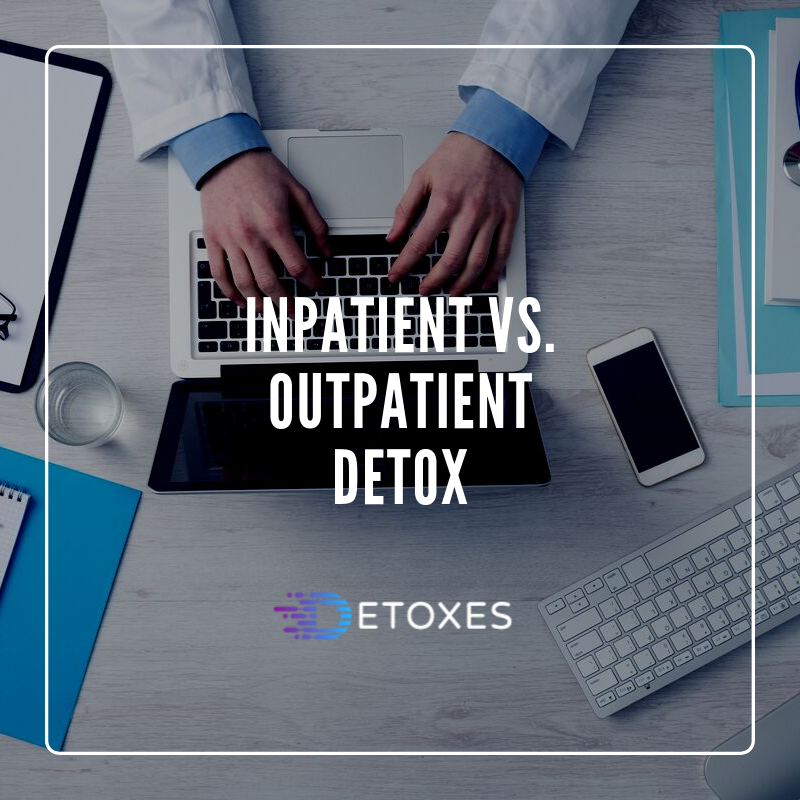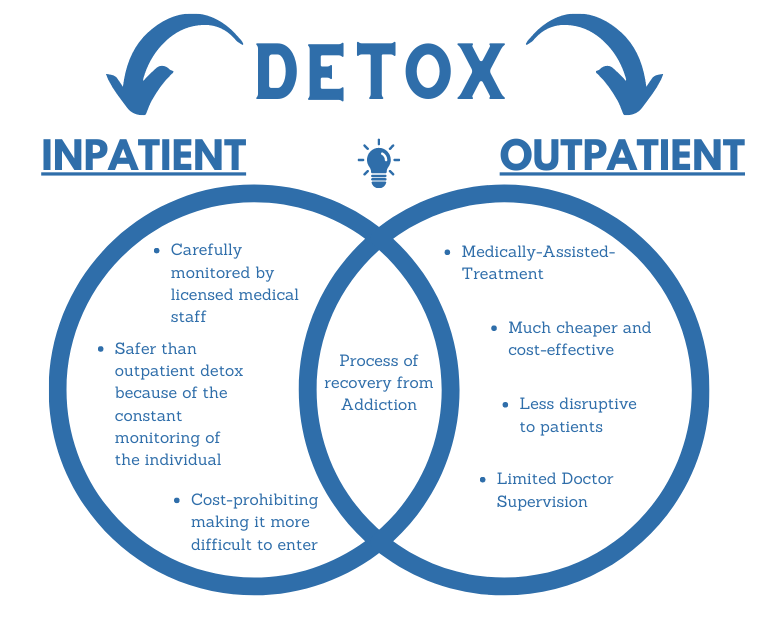Inpatient vs. Outpatient Detox | What is The Difference?
Article Contents
Detox is an important step in the process of recovery from addiction. One of the first decisions to be made when a person is suffering from addiction is whether to have an inpatient or outpatient detox. It often depends on how severe a problem the individual has because in some cases, such as alcohol withdrawal, severe and dangerous symptoms can occur in which case an inpatient detox should be done.
The particular substance involved is an important factor that doctors need to take into account when deciding on the safest and most effective detox option for the patient. This is because the withdrawal from certain substances such as benzodiazepines and alcohol can be extreme and may require careful medical supervision to ensure safety of the patient. Addiction to substances such as marijuana is usually much milder and the symptoms of withdrawal are not dangerous.
Healthcare providers sometimes use a specific protocol during treatment of alcohol addiction, to assess if a patient needs inpatient or outpatient treatment1. The type of addiction and level of severity are important factors included in many protocols because there are cases, such as with alcohol, for instance, when detox can be life-threatening and careful monitoring is needed.
Another factor that many professionals take into account is how long a person has been addicted to a particular substance, and if they are addicted to multiple substances since this makes the detox more complicated.
How inpatient detox works
Although inpatient detoxification is crucial in treatment of patients with severe addictions, researchers believe that further inpatient treatment of substance abuse is also critical to successful recovery2. Inpatient detoxification is also often needed for addictions to alcohol or benzodiazepines because the withdrawal process can be very severe and even dangerous.
Inpatient detox requires that a person be hospitalized and that their withdrawal symptoms be carefully managed by experienced professionals. The withdrawal symptoms can be medically treated within the facility and in some cases, medication given to alleviate severe symptoms of withdrawal3.
It therefore has the advantage of being safer than outpatient detox because of the constant monitoring of the individual. The patient also cannot slip up and start using again because they are in a facility where everything is controlled. A disadvantage of inpatient detox is that it is more expensive than outpatient detox and it can be hard to get health insurance to pay for it. Often a person may have to pay out-of-pocket which gets very expensive.
Several factors influence the success of inpatient detox on patients. Social, economic and personal motivation all influences the success rates of detox programs2. Inpatient detox is crucial for cases of severe substance addiction and abuse.
People with severe alcohol addiction can suffer very dangerous withdrawal symptoms including delirium tremens which includes seizures. Researchers have found that inpatient detox and treatment is more effective in helping patients with more severe alcohol addictions compared with outcomes when outpatient detox is used4.
How outpatient detox works
Outpatient detox is when patients go to treatment during the day and then return home at night. Treatment may last several days. There are advantages to outpatient treatment, for one, it is much cheaper and cost-effective, which is important particularly considering that medical insurance may not cover the cost of inpatient detox and treatment. It is also less disruptive to a patient who can then continue many of their activities of daily life. There are cases where outpatient detox is effective for substance abuse, including alcohol addiction.
Studies have shown that psychotropic medication can be helpful in treating patients with withdrawal symptoms during the detox process and this often increase the success rate of outpatient treatment of people with alcohol addiction5.
Some medications such as carbamezapine are not addictive and are therefore safe to use on an outpatient basis for those individuals experiencing withdrawal from alcohol6. This drug is also used on an inpatient basis, where it is combined with other medications such as methadone or buprenorphine7.
Outpatient detoxification may not be advisable if addiction to alcohol or other substances is severe and the person has been addicted for a long time. In these situations the withdrawal process may be too dangerous for outpatient detox.
Level of severity of an addiction can also be a strong predictor of the success of an outpatient detoxification treatment plan. In fact, this has been found to be true for cocaine addiction8.
To sum up
In summary, the choice of which detox method is suitable for a person depends on a number of factors. There is the higher cost associated with inpatient detox, but this is a safer alternative and may be the only solution for patients who have a severe addiction.
The type of addiction is also an important factor, and certainly the withdrawal symptoms associated with a bad alcohol or benzodiazepine addiction can be dangerous. In these cases, it may not be safe to do outpatient detox.
For milder addictions, outpatient detox is a viable choice, and it has several advantages including the fact that it is a cheaper option. It also means less disruption to a person’s daily activities. Ultimately the choice of inpatient versus outpatient detox needs to be made after careful consultation with physicians and addiction specialists.
References
- Stephens, J. R., Liles, E. A., Dancel, R., Gilchrist, M., Kirsch, J., & DeWalt, D. A. (2014). Who needs inpatient detox? Development and implementation of a hospitalist protocol for the evaluation of patients for alcohol detoxification. Journal of general internal medicine, 29(4), 587-593.
- Franken, I. H., & Hendriks, V. M. (1999). Predicting outcome of inpatient detoxification of substance abusers. Psychiatric Services, 50(6), 813-817.
- Hayashida, M. (1998). An overview of outpatient and inpatient detoxification. Alcohol health and research world, 22, 44-46.
- Rychtarik, R. G., Connors, G. J., Whitney, R. B., McGillicuddy, N. B., Fitterling, J. M., & Wirtz, P. W. (2000). Treatment settings for persons with alcoholism: Evidence for matching clients to inpatient versus outpatient care. Journal of Consulting and Clinical Psychology, 68(2), 277.
- Soyka, M., & Horak, M. (2004). Outpatient alcohol detoxification: implementation efficacy and outcome effectiveness of a model project. European addiction research, 10(4), 180-187.
- Mayo-Smith, M. F. (1997). Pharmacological management of alcohol withdrawal: a meta-analysis and evidence-based practice guideline. Jama, 278(2), 144-151.
- Seifert, J., Metzner, C., Paetzold, W., Borsutzky, M., Passie, T., Rollnik, J. et al. (2002). Detoxification of opiate addicts with multiple drug abuse: a comparison of buprenorphine vs. methadone. Pharmacopsychiatry, 35(05), 159-164.
- Kampman, K. M., Pettinati, H. M., Volpicelli, J. R., Oslin, D. M., Lipkin, C., Sparkman, T., & O’Brien, C. P. (2004). Cocaine dependence severity predicts outcome in outpatient detoxification from cocaine and alcohol. American Journal on Addictions, 13(1), 74-82.





